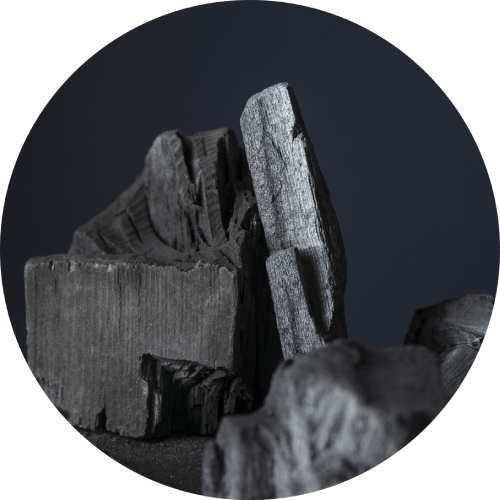Natural graphite

Foundry graphite, cryptocrystalline type (GLS)
GLS-1 to GLS-4 grades of cryptocrystalline foundry graphite are used in foundry shops for lubricating casting molds.
The more complex the shape of the casting and the higher the surface finish requirements, the higher the grade of cryptocrystalline graphite required.
The main differences between GLS-1, GLS-2, GLS-3, and GLS-4 grades lie in their ash content by mass:
- GLS-1 – 13%
- GLS-2 – 17%
- GLS-3 – 22%
- GLS-4 – 25%
Crucible graphite (GT), crystalline type
GT-1 graphite is used for the production of refractory products, graphite gland packings, gaskets, oxidized graphite, and more.
The addition of crucible-grade graphite improves the thermal conductivity and chemical resistance of the final products.
Therefore, it is widely used in manufacturing equipment for the chemical industry, such as various crucibles, plugs, cups, retorts, and similar components.
Technical specifications of GT-2 crucible graphite:
- Ash content: not more than 8,5%
- Residue on 0.2 mm sieve: not less than 75%
- Mass fraction of iron (as Fe₂O₃): not more than 1,6%
Lubricating graphite (GS), graphite P, crystalline type
Finely dispersed graphite powder is added to liquid lubricants to produce high-performance graphite grease.
Graphite grease is used in heavily loaded mechanical components and industrial equipment, such as rolling mill gears, wheelsets, crane wheel axles, and similar parts.
It is also used in the production of electrically conductive films and electrically conductive rubber.
Foundry graphite (GL)
GL-grade graphite is a highly demanded material, especially widely used in the foundry industry.
GL graphite is a filler in paints used to create a protective anti-stick coating on casting molds.
It is also added to sand and slag-forming mixtures.
Key industries where foundry graphite is used include the metallurgical and oil & gas sectors.
GL-1 grade graphite is used in the production of technical diamonds, refractory products, and more.
In addition, this material is applied in the aerospace industry to protect spacecraft from thermal exposure.
Pencil graphite (GK), crystalline type
Pencil-grade graphite does not contain hard impurities such as quartz or iron.
Its structure is soft and finely ground.
Graphite grades GK-1, GK-2, GK-3, and GK-4 are used in the production of pencils.
Battery-grade graphite (GAK), crystalline type
Battery-grade graphite is produced from natural crystalline graphite.
After purification, GAK graphite contains a minimal amount of impurities.
According to GOST 10273, the following grades are distinguished: GAK-1, GAK-2, and GAK-3.
GAK-1, being the purest grade, is intended for the production of special-purpose battery cells.
GAK-2 is used in battery-powered electric tools.
GAK-3 has low electrical resistance and is chemically inert — properties that make it suitable for use in the electrolytic smelting of ferrous and non-ferrous metals.
Visually, battery-grade graphite is a solid or powder of dark gray color, ranging from light silvery-gray to black.
The powder adheres to solid surfaces, forming a thin graphite film.
Preparations based on natural graphite, colloidal graphite preparations, and CGP S-1
We manufacture colloidal graphite preparations in accordance with TU 113-08-48-63-90.
We also produce colloidal graphite GK-1 under TU 6-08-316-75.
GK-1 graphite is used for applying external electrically conductive coatings to electron-beam tubes, and for lubricating components and mechanisms of presses during the formation of cable sheaths in the cable industry.
Graphite grades S-0, S-1, S-2, and S-3 have microgranule sizes of 1.5, 4, 15, and 30 microns, respectively.
The primary areas of application for these graphites include the electronics, agriculture, and chemical industries.
For example, S-1 is used in the production of:
- Lubricating compositions
- Coatings for technical componentssuch as contacts and resistors
- Anti-friction powder for seeders
Flake graphite
Flake graphite is a natural graphite known for its bright metallic luster, which is why it is sometimes referred to as silver graphite.
The structure of silver graphite provides high electrical conductivity and plasticity.
Like all graphites, flake graphite is chemically stable and has a very high melting point — nearly 4000°C.
As a result, flake graphite of various particle sizes is commonly used in the production of refractory materials, metallurgy, and as a component in special lubricants and paints.
Special low-ash graphite
We manufacture and supply low-ash graphite grades from stock, including GSM-1, GSM-2, GE, and TMZ.
Low-ash graphite is characterized by high thermal conductivity, enhanced refractory properties, and low impurity content.
GSM-1 and GSM-2 graphite do not emit volatile substances when heated, which makes them suitable for the production of synthetic diamonds and protective shielding materials.
GSM-2 is especially in demand in the metallurgical industry for the smelting of high-strength alloys.
The specifications of GSM-1 and GSM-2 are regulated by GOST 18191-78 and GOST 17022-81.
Lubricating graphite
The layered structure of graphite is responsible for its excellent lubricating properties.
Moreover, graphite is highly resistant to elevated temperatures.
In industrial applications, graphite lubricant rods are used as solid lubricants.
In some cases, these rods are manufactured hollow and filled with soft (plastic) lubricants.
During operation, lubricant rods are gradually consumed in high-load friction pairs, providing consistent lubrication throughout the mechanism’s service life.
